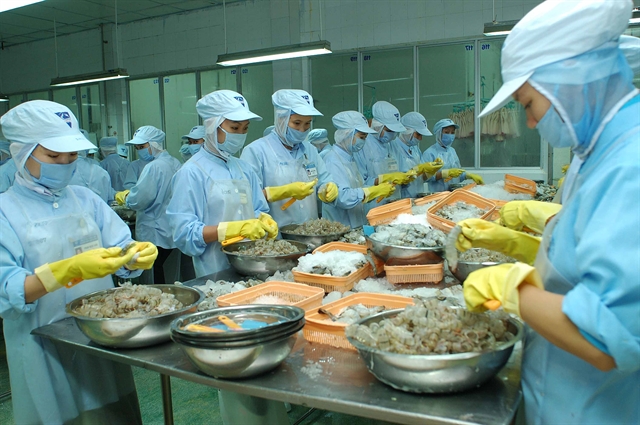 Economy
Economy


|
| Processing shrimp for export. The agricultural sector will focus on the development of seafood and forestry products in the second half of this year. Photo daidoanket.vn |
HÀ NỘI – The agricultural sector in the second half of this year will focus on the development of commodities that have potential in production and export growth such as seafood and forestry products, said Minister of Agriculture and Rural Development Nguyễn Xuân Cường.
Especially, fishery and forestry industries have many opportunities to support the sector in achieving its growth targets in gross domestic product (GDP) and exports for the whole year, he said. The global prices of seafood products are not high, but the fishery industry still has a chance to increase its revenue.
Therefore, the sector will focus on developing these two products in the second half of this year, Cường said.
Nguyễn Quang Hưng, Deputy Head of the Directorate of Fisheries, said the fishery industry can gain strong development in shrimp and tra fish in the last six months with output growth of 7.5 per cent each in production and exploitation of aquaculture.
Particularly, the shrimp export value will contribute a large part to the agriculture sector’s total export value in the second half of the year.
Other commodities like tuna, crustaceans and molluscs also have many opportunities to develop in the second half of the year, Hưng said.
The forestry industry will focus on increasing timber production by over 8 per cent, meeting the demand for processing and exporting.
Meanwhile, the effectiveness of the Voluntary Partnership Agreement (VPA) on Forest Law Enforcement, Governance, and Trade (FLEGT) between the European Union (EU) and Việt Nam from June 2019 is a great opportunity to increase Việt Nam's wood product exports to the EU.
The signing of the Việt Nam-EU Free Trade Agreement on June 30, 2019 will also create many opportunities on trading agricultural products between the two sides.
However, it is certain that there will be non-tariff barriers and the agricultural sector must overcome those. Therefore, Cường said the sectors must reorganise production to have products with high quality, good design and more reasonable prices.
Besides that, the cultivation and livestock industry also needs to accelerate restructuring. Especially, livestock must have solutions to stop the spread of African swine fever, reducing damage and ensuring growth of the farming sector. Along with that is accelerating poultry and large livestock, but attention must be paid to sustainability factors.
The agricultural development targets of 2019 include 3 per cent in GDP growth rate; export value at $43 billion; rice output at a similar volume to 2018 and strong growth in production of vegetables, fruit and some industrial trees with high consumption.
Livestock industry will increase output of poultry products by about 13-14 per cent; eggs by about 12 per cent and beef by about 7 per cent.
At present, the Ministry of Agriculture and Rural Development (MARD) is also preparing profiles to get permission on exporting some kinds of fruits to the US such as grapefruits, avocado, durian and others, and to Japan like lychees, longans, grapefruits, rambutans and star apples.
In addition, the sector also has to pay attention to the domestic market, avoiding losses in the home market.
According to the ministry, in the first six months, the export value of the whole industry is estimated at $19.77 billion, a year on year increase of 2.2 per cent while its trade surplus reached $4.2 billion, up 4.6 per cent compared to the first six months of 2018.
Nguyễn Văn Việt, Director of the Planning Department, said in the first half of this year, many kinds of fruits were exported to new export markets such as mango to the US, the UK and Australia, and mangosteen to China.
During the first half of the year, Việt Nam and China signed a protocol to export milk and milk products from Việt Nam to China.
Việt said the sector could not gain high growth in export value due to the strong decline in export prices of many key agricultural products compared to the same period in 2018, including pepper, rubber, coffee, rice, cashew nuts, cassava and products from cassava, shrimp and tra fish, while Việt Nam’s export value to China also decreased.
Meanwhile, many export markets of Việt Nam have had more strict technical barriers, policies on import quota, new requirements for traceability and export certificates, and quality inspections, especially China which is one of the largest export markets for Vietnamese farming products. — VNS




